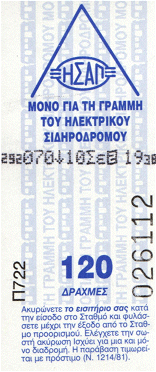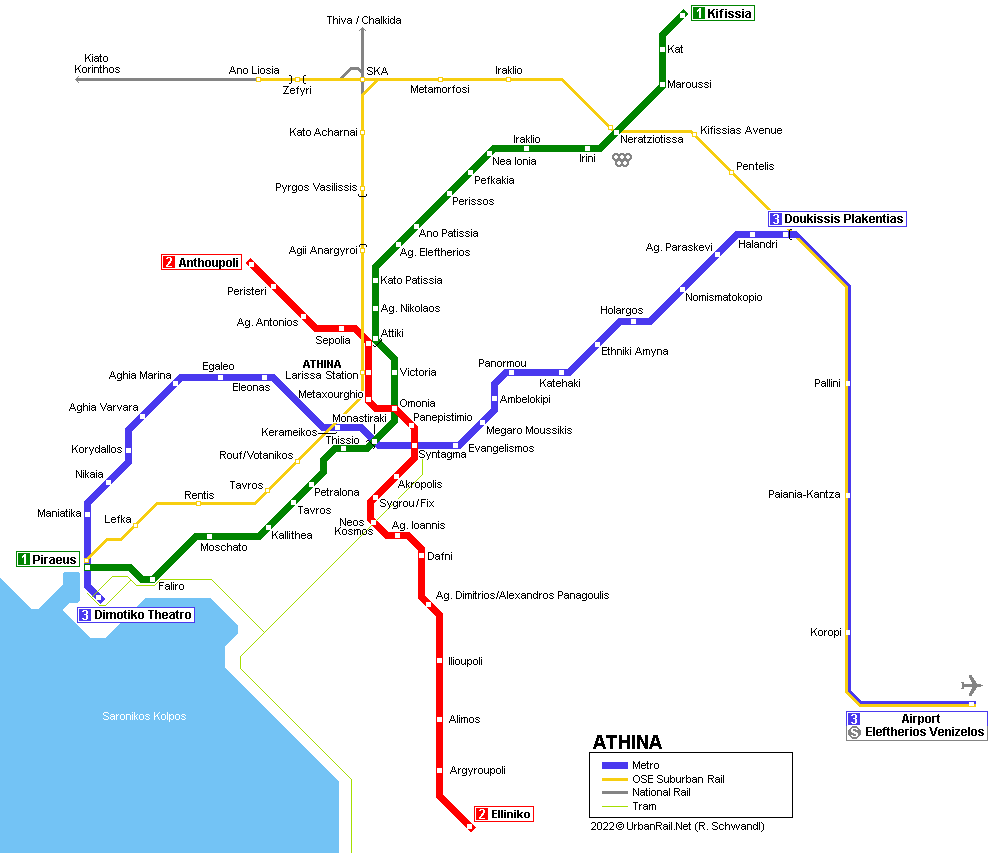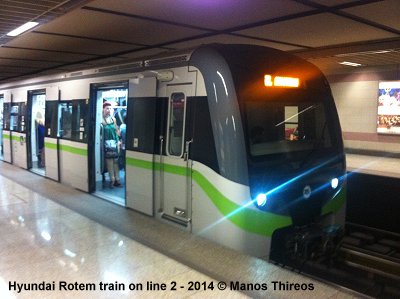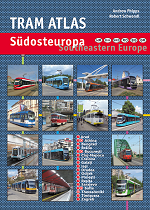|
[ UrbanRail.Net ] [ Europe ] [ Americas ] [ Asia ] [ Africa ] [ Oceania ] [ News ] [ Books ] [ Links ] |
| Greece |
Click on map to see lines under construction or planned!
| System | |
|
Athens, one of Europe's oldest capitals, has more than 3 million inhabitants. The city hosted the Olympic Games in August 2004. The current metro network consists of 3 lines, including one line in operation since 1869 and two modern lines only opened a few years ago. The total length of the network is approx. 65 km with 68 stations (July 2020).
|
|
| Line 1 Piraeus - Kifissia | 25.6 km (3 km underground), 24 stations |
|
In 1867, construction of the railway was awarded to the English businessman Edward Pickering, and work began on the 8 km line from Piraeus to Athens, which terminated at what is today Thissio station. The line was, of course, entirely on the surface and was steam-operated. Construction was completed on 17 February 1869, on which day the first test run took place, with the official opening ceremony following ten days later. The line was electrified in 1904 and finally extended underground (3 km) through the city centre and further to Kifissia in 1957, when it began to operate as a real metro line. Line 1 used to be owned and operated by ISAP (Athens-Piraeus Electric Railway) S.A., which was the new company created by the nationalisation of Greek Electric Railways in 1976, before being taken over by STASY in 2011.
|
|
| Line 2 Anthoupoli - Elliniko | 17.7 km, 20 stations |
|
The first section of Line 2 opened on 28 January 2000, between Sepolia in the north-west to Syntagma in the city centre. The line includes two interchanges with Line 1 at Attiki and Omonia, with the Main Line and Suburban Rail trains at Larissa Station.
|
|
| Line 3 Dimotiko Theatro - Doukissis Plakentias (- Airport) | 21 (+21) km, 24 (+4) stations |
|
At first, this line was perceived as a branch of Line 2 branching off at Syntagma and going to Ambelokipi, but later evolved into a separate line, planned to run from Egaleo in the west to Gerakas in the northeast. The line approved for construction in the late 1980s was from Keramikos (about 200m north of Line 1's Thissio station) to the west of the city centre, to the Pentagon (Ethniki Amyna) in the northeast. Eventually, the instability of the ground in the area west of Syntagma, as well as the larger number of ancient remains than expected, led to the curtailing of the line to Monastiraki. Even there, the opening was delayed for three years because of building difficulties. To avoid collapse of the tunnel to Monastiraki, smaller bore tunnels were dug around it using miniature TBMs and these were filled with concrete to stabilise the soil. Monastiraki offers interchange with Line 1 and its traditional ticket hall building was renovated and restored, while a second entrance was provided at Athenas Street. Monastiraki opened on 22 April 2003. From Doukissis Plakentias, some trains surface and change power supply from 750V dc third rail to 25kv AC overhead, and run on the same tracks as the Suburban Rail to the Athens Airport, "Eleftherios Venizelos", initially without stopping at intermediate stops. METRO TRAINS
21
new trains were also built for Attiko Metro S.A. by ROTEM of Korea for
the extensions on Lines 2 and 3. The new trains will break away from
the traditional design used since 1984 for Athens Metro trains (all
3 lines) and will have several new features: Out of these trains, 14 will be 750 V DC (direct current) operated for use on Line 2 and Line 3 as far as D. Plakentias. They will have 204 seats and room for 840 standing passengers. The remaining 7 will be dual-voltage (750 Vdc/25KV ac) units for use on services to the airport. These will only have 185 seats, as some of the floor space will be used for luggage. These will also be air-conditioned. All trains will have six cars. |
|
| History | |
| For detailed opening dates see each line: L1 | L2 | L3 | |
|
Projects |
|
|
Line 4 - In Dec. 2005, detailed plans for a new U-shaped line were published linking two formerly planned branches. Section A between Alsos Veikou and Goudi (12.8 km) has been under construction since late 2021. For route alignment and further projects see project details and map. |
|
| Book | |
|
|
| Links | |
|
STASY (Statheres Sygkoinonies S.A.) (Metro & Tram Operator - Official Site) Hellenic Metro (Metro construction company) Proastiakos (Suburban Railway - official site) OASA - Athens Urban Transport Athens Metro at Wikipedia Origin of Station Names (by Panayiotis Constantinides) Suburban Railway Map 2004 (© Panayiotis Constantinides) Another map by Panayiotis Constantinides News about Greek Metros (Kathimerini Newspaper)
|
|
John Fragakis (Athens,Greece) reports on opening ceremony, 28 Jan 2000:
 The
partial opening of the new Athens Subway System was widely celebrated among
politicians and citizens, as a reliable infrastructure that would offer the
city a much more promising future. It is a general fact that the Athens metro
will contribute a lot to the city's legendary traffic conditions: distances
travelled in 1 hour during peak times, can now be reduced to 9 minutes!
The
partial opening of the new Athens Subway System was widely celebrated among
politicians and citizens, as a reliable infrastructure that would offer the
city a much more promising future. It is a general fact that the Athens metro
will contribute a lot to the city's legendary traffic conditions: distances
travelled in 1 hour during peak times, can now be reduced to 9 minutes!
KEY FEATURES: The basic project consists of two lines running from northeast to southwest [line 3] and from northwest to southeast of the central area [line 2] corresponding at "Syntagma" transfer station. An older existing line [line 1 or "ISAP"), historic, as it is operating since 1869, is linked to the new network at "Omonia" - most central square of Athens -and two more stations. Additionally, the new network includes 18.2 km of line length, 21 new stations and is built totally underground. Two TBMs (tunnel boring machines) were used to open the tunnels, and stations were built using both NATM and Cut-and-Cover methods. A basic question asked about Athens metro is how the construction of such a large project would not affect the city's vivid historic nature, as it is taking place in the most interesting locations of classical times. In fact, building the metro, offered a unique chance to bring to light a multitude of archaeological treasures and promote the research over the form and features of the city throughout the centuries. The most extended excavations ever known in Athens took place in stations like Syntagma, Academia and Olympieion revealing bathhouses, metal working shops, aqueducts and cisterns, ancient roads and city walls and even an enigmatic room with oil lamps decorated with erotic scenes. Many of the smaller exhibits are presented in the stations themselves, while "Syntagma" can boast a ground's section preserved to its original stratigraphy and can be seen through a curtain wall. The rest of the project lies to the safety of great depths as it is built 20-30m below surface, which is far from public infrastructure networks and antiquites level, thus avoiding costly and time consuming disruptions. The geological and geotechnical conditions along the 18 km alignment of Athens Metro lines have been extensively investigated, analysed and evaluated. A vast number of boreholes were performed prior and during the construction period drawing valuable conclusions over the geophysical and geotectonical features of the subsoil and the presence of water. Everybody learned about "Athens Schist", scientifically described as a sequence of originally sedimentary, flysch-like rocks of possible Upper Cretaceous age, that have been subsequently subjected to metamorphosis". Despite the knowledge acquired through studies, real-time conditions proved significantly diverse. Unstable soil caused numerous problems across several parts of the city center as a demolition of a building and continous subsidences in "Panepistimiou" avenue. Metro was making news all throughout October 1997, when viewers experienced, during a regular live transmision, the unexpected disappearing of a news-stand into the ground. Hundreds of tons of concrete were needed to stabilize the soil causing an unprecedented mess on already congested traffic and leading to a series of disputes about responsibility.
EXTENSIONS. According to a metro development study, carried out during the construction period, several extension projects have been scheduled. Four of them are to be completed by 2004 - year of the Olympic games for Athens - and two more by 2006 adding a total length of 27.4 km and 23 new stations to the network. Line 3 [Ethniki Amyna-Syntagma] will be extended in both directions heading for "Stayros"- a key interchange of a new freeway and future railway leading to the new Athens international airport at Spata- and "Egaleo"- a densely populated western suburb. Line 2 [Sepolia-Dafni] will continue to "Peristeri"- one of the largest urban concentrations in Athens- and "Glyfada", joining the city center with the sea-front.
Thanks for this contribution to UrbanRail.Net in March 2000.
2004 © UrbanRail.Net by Robert Schwandl.







 In
summer 2003, delivery of the 20 new 6-car trains for Line 1 (ISAP S.A.)
was completed. The old trains (8 trains dating from 1959/1968 and 7
dating from 1983-1985) have been withdrawn. The 1983-built trains, built
in East Germany, are all heading for scrapping. At least two of the
1959/1968 trains will be restored and preserved in working order at
Piraeus depot, while some are being converted for special duties. Thus,
Line 1 now only has two basic types of rolling stock, the 24 five-car
trains delivered in two batches in 1984/85 and 1994/95, and the 20 new
six-car trains built between 2000 and 2003. A 1984-built 5-car train
has been experimentally fitted with air-conditioning, and all 44 trains
were later retrofitted with such a system.
In
summer 2003, delivery of the 20 new 6-car trains for Line 1 (ISAP S.A.)
was completed. The old trains (8 trains dating from 1959/1968 and 7
dating from 1983-1985) have been withdrawn. The 1983-built trains, built
in East Germany, are all heading for scrapping. At least two of the
1959/1968 trains will be restored and preserved in working order at
Piraeus depot, while some are being converted for special duties. Thus,
Line 1 now only has two basic types of rolling stock, the 24 five-car
trains delivered in two batches in 1984/85 and 1994/95, and the 20 new
six-car trains built between 2000 and 2003. A 1984-built 5-car train
has been experimentally fitted with air-conditioning, and all 44 trains
were later retrofitted with such a system. 